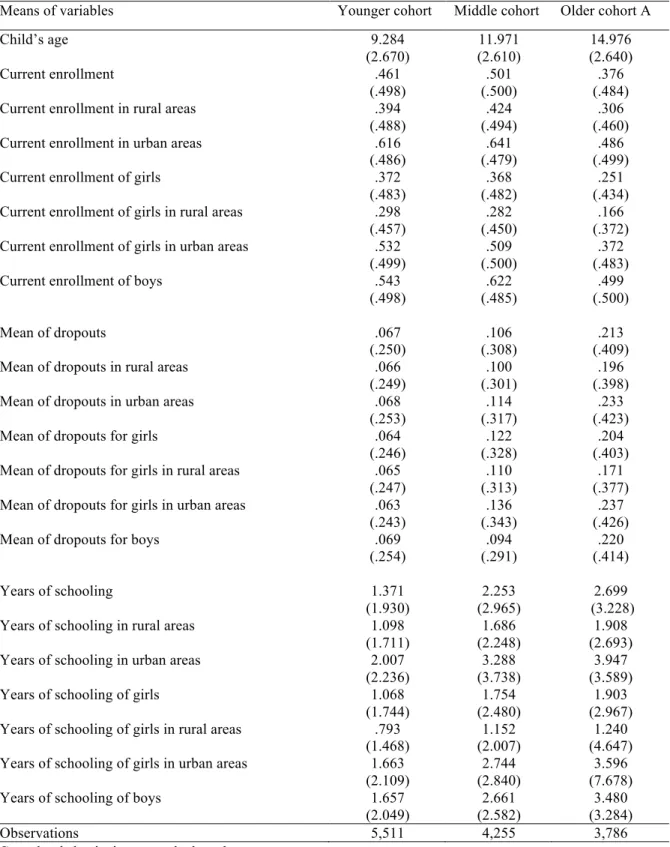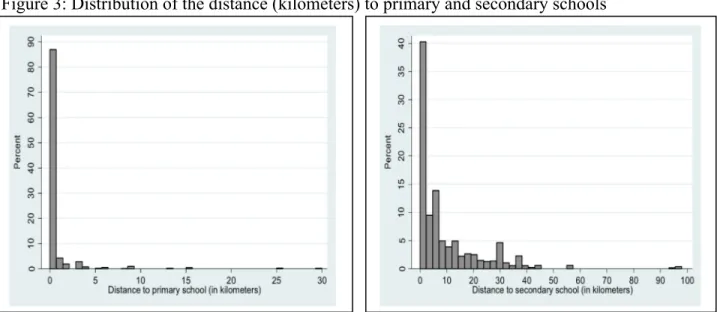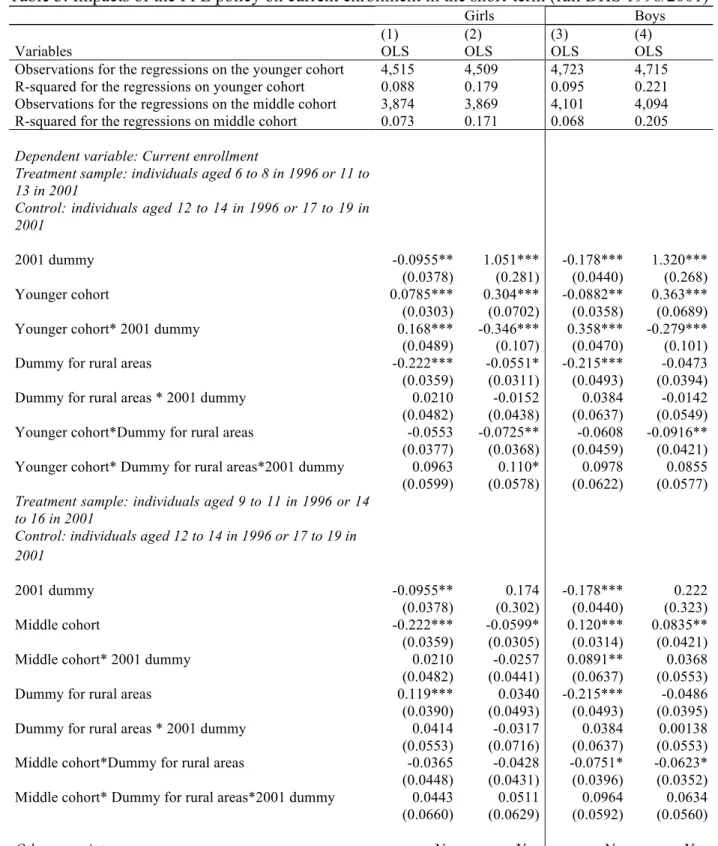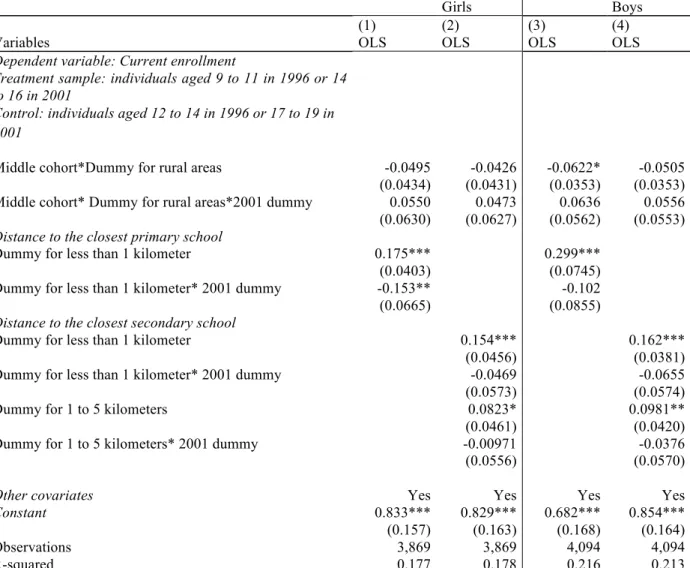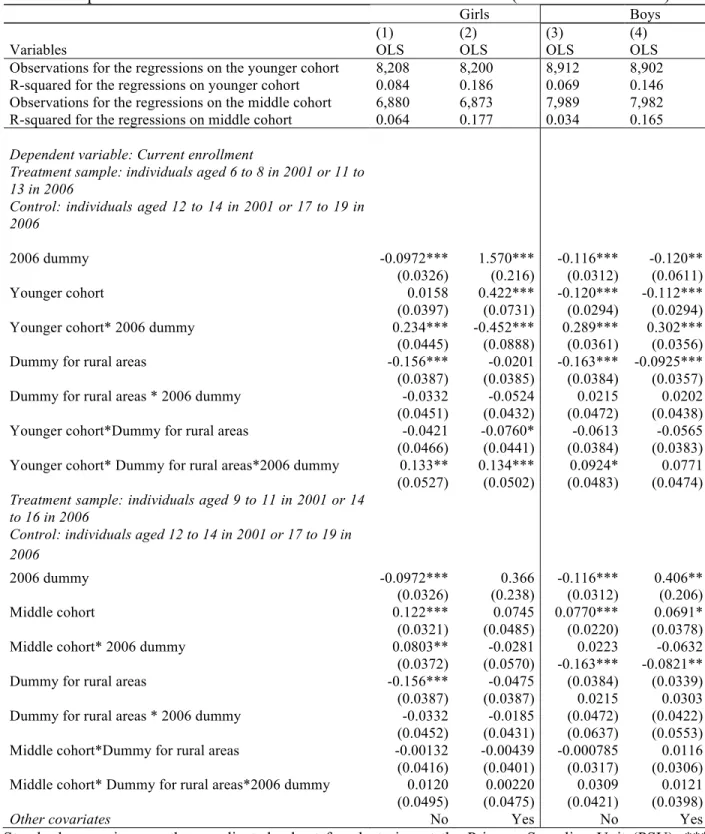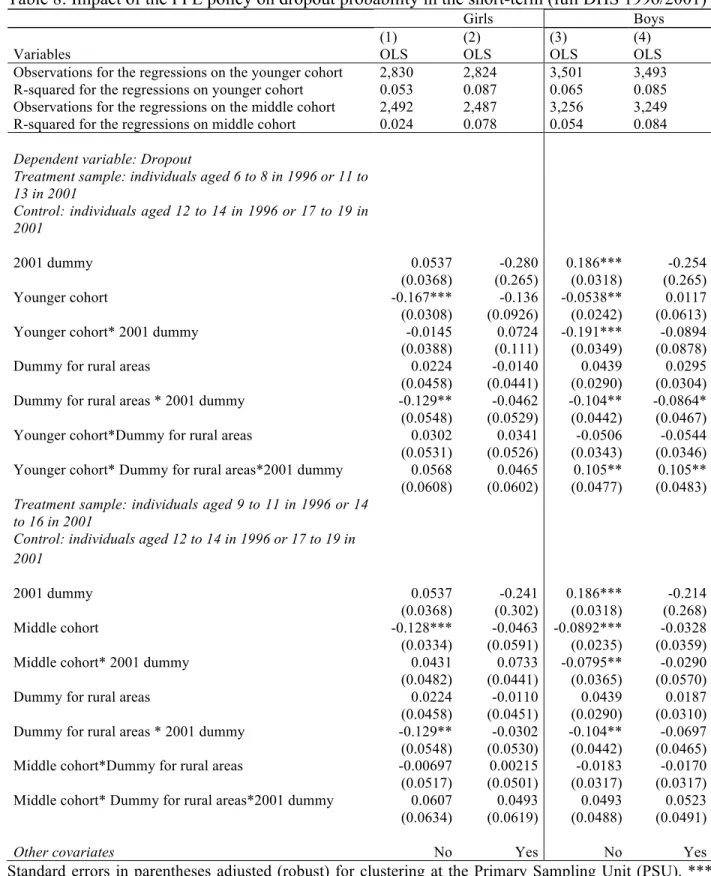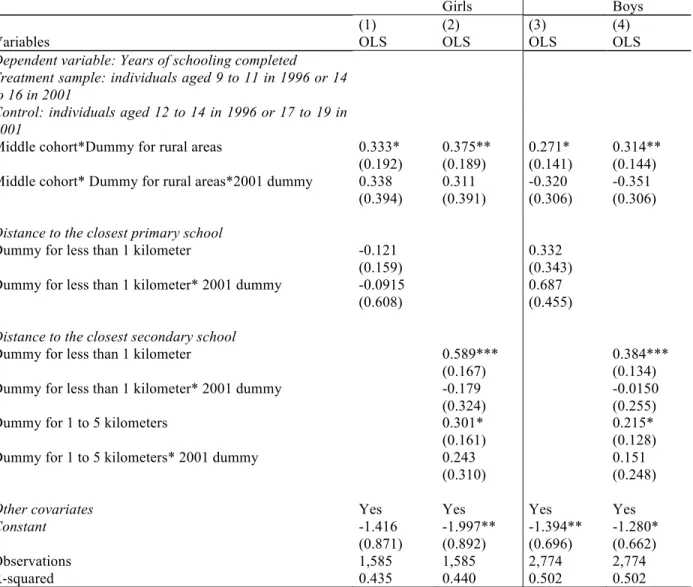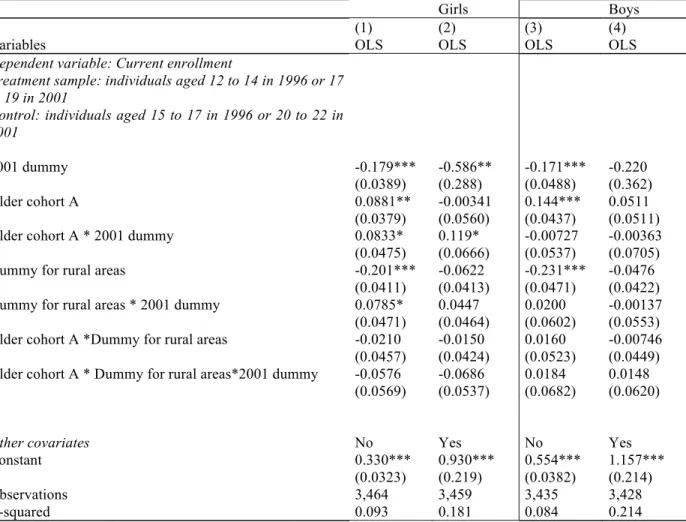Impacts of school costs, school infrastructure and household wealth on girls’
schooling under the Free Primary Education policy: the case of Benin, West Africa
Kumulative Dissertation
Inaugural-dissertation in der Fakultät: Sozial und Wirtschaftswissenschaften Der Otto-Friedrich Universität Bamberg, Deutschland
Vorgelegt von
Mafaïzath Aramidé Fatoke Dato MSc., geb. am 10.05.1986 in Cotonou, (Benin)
Bamberg, den 14 August 2015
Impacts of school costs, school infrastructure and household wealth on girls’
schooling under the Free Primary Education policy: the case of Benin, West Africa
Inaugural-dissertation, Faculty of Social Sciences, Economics and Business Administration, Otto-Friedrich University of Bamberg, Germany
Submitted by
Mafaïzath Aramidé Fatoke Dato MSc. born on 10.05.1986 in Cotonou (Benin)
Bamberg, 14th August 2015
Tag der mündlichen Prüfung: 16/12/2015
Gutachter: Prof. Dr. Eveline Wittmann
Technische Universität München (TUM) Lehrstuhl für Berufspädagogik
TUM School of Education München, Deutschland Prof. Dr. Guido Heineck
Otto-Friedrich Universität Bamberg
Lehrstuhl für Volkswirtschaftslehre insbesondere Empirische Mikroökonomik Sozial und Wirtschaftswissenschaften Fakultät
Bamberg, Deutschland
Prof. Dr. Katharina Michaelowa
Universität Zürich
Lehrstuhl für die Politische Ökonomie der Entwicklungs- und Schwellenländer Institut für Politikwissenschaft
Zürich, Schweiz
Day of defense: 16/12/2015
Reviewers: Prof. Dr. Eveline Wittmann
Technische Universität München (TUM) Full Professor of Vocational Education TUM School of Education
Munich, Germany Prof. Dr. Guido Heineck
Otto-Friedrich University of Bamberg Chair of Economics-Empirical Microeconomics
Faculty of Social Sciences, Economics and Business Administration Bamberg, Germany
Prof. Dr. Katharina Michaelowa
University of Zurich
Professor of the Political Economy of Developing and Emerging Countries Institute of Political Sciences
Zurich, Switzerland
“Knowledge is power. Information is liberating. Education is the premise of progress, in every society, in every family.”
Kofi Annan, 7
thSecretary-General of the United Nations, June 23, 1997
Acknowledgements
This work would not have come to fruition without the support of many people, and I would like to take this opportunity to express my appreciation and deepest gratitude to them. I am sincerely grateful to my supervisor Prof. Dr. Eveline Wittmann for her guidance and faith in me.
She did not hesitate to give me the opportunity to work under her supervision, and I thank her for the academic researcher that I have become as a result of this support. I wish to express my sincere gratitude to Prof. Dr. Guido Heineck, who took the time in his busy schedule to read my work and offer advice on my research. I would like to thank Prof. Dr. Katharina Michaelowa for her advice and assistance in sourcing the data and other materials. I am also extremely grateful that she recommended me to my supervisor.
My gratitude goes to Prof. Dr. Michael Grimm for his advice, comments, and suggestions.
Despite having no obligation towards me he took the time to read and correct all my papers, and I am very thankful to him for his assistance. I am extremely grateful to Dr. Honorat Satoguina who, was kind enough to help me with the process of the DAAD scholarship. I am also grateful to the German Academic Exchange Service (DAAD) for the Ph.D. scholarship, and for their support. I would like to thank Prof. Dr. Detlef Sembill and the department of Business Education and Educational Management (University of Bamberg) for the office made available to me for the duration of my doctoral studies.
I am grateful to Prof. Dr. Mareva Sabatier and the Laboratory “Institut de Recherche en
Economie et en Gestion (IREGE)” of the University of Savoie, France, who kindly hosted me
during my visiting research. They gave me the opportunity to discuss and work with other
colleagues in my field, which was a priceless experience. I am thankful to Dr. Anna Risch for her
suggestions and comments about my research. I would like to thank my colleagues of the
Department of Business Education and Educational Management (University of Bamberg,
Germany). I would like to express my sincere gratitude to the Bavarian Graduate Program in
Economics (BGPE) for the opportunity to learn during the graduate courses and workshops. This
program was essential for my doctoral studies, and I am thankful to everyone, who assisted me
during our different workshops, graduate courses and after. I am also thankful to the Bamberg
Graduate School of Social Sciences (BAGSS) for the different opportunities and the courses. I
would like to acknowledge the Bamberger Graduiertenschule für Betriebswirtschaftslehre
(BAGSB). I also wish to acknowledge Prof. Dr. Franck Portier and Mrs. Aude Schoelsing of the Toulouse School of Economics (TSE) for their assistance.
Finally, I would like to express my gratitude towards my family and friends for their support and prayers. I dedicate this work to my parents Miftaou and Ernestine Fatoké, who taught me the importance of faith, dedication and perseverance. I am especially thankful to my husband
Prudence Dato. Thank you for being my best friend, my love and my colleague, and for listening
to me and pushing me when I needed it. None of this would be possible without your patience
and your unwavering support. I would like to thank my siblings Farida, Yusuf and Aweni Fatoké
for their prayers and support as well. I am also grateful to my family-in-law for their patience and
prayers. I am thankful to my friends Alexandre Zoumenou, Arnaud Behanzin, John-Paul and
Rose Bachani, Mounirou Abdoulaye and Etienne Duchâtel. Lastly, I would like to thank all the
women in my extended family for being my role models.
Abstract
To reach the Millennium Development Goal of Universal Primary Education (UPE), developing countries have implemented numerous educational policies (United Nations, 2014). Despite the remarkable upsurge in schooling in these countries, gender-related inequalities are persistent, particularly in levels of attainment. A recent report of United Nations specified that only 23% of girls in poor rural households do complete the primary level of education in Sub-Saharan Africa in 2011 (UNESCO, 2014). This dissertation provides three potential explanations for these issues: the schooling costs; the school infrastructure; and the household wealth. The first explanation relates to the remaining schooling costs. Indeed, policies of removal of school fees often neglect that parents also support other kinds of schooling costs. These residual costs are the indirect costs and the opportunity costs, which are reasonably high in some developing countries.
In the case of Benin, a West African country, despite the removal of school fees, the residual schooling costs remain high. Thus, the dilemma of which child to send to school is still relevant for poor households. The evaluation of the elimination of school fees in Benin provides evidence for this argument. The poor quality of schools' infrastructure in developing countries could be a second explanation for the gender gap in schooling. The long distances to the closest primary school, the large numbers of pupils in the classrooms, the lack of teachers and pedagogical materials are all factors that could discourage children―especially girls―in their school attendance. The evaluation of a demand-and-supply policy indicates the importance of a removal of school costs and the upgrading of the schools’ infrastructure to reduce the gender gap in schooling. The third explanation relates to the importance of the household wealth on schooling decisions. A policy that eliminates school fees could maintain the dependence of schooling decisions on household wealth by neglecting the remaining schooling costs. In such a case, a wealth shock could be detrimental to the gender gap in schooling and on the efforts already engaged in to reach the goal of UPE. The assessment of the impact of a negative wealth shock on children’s schooling and labor in Benin provides empirical evidence for this argument.
The contributions of this dissertation are both theoretical and empirical. On one hand, this
research meaningfully extends the literature on impact evaluation in Benin. Crucially, the country
lacks research studies that evaluate economic policies. On the other hand, the relevance of the
dissertation also lies in the analysis of the relationship between price and wealth effects. These
effects are observed through the reactions of households to wealth or price changes. They
indicate which policy―based on the schooling price or the household wealth―should be
prioritized to enhance education in Benin. On the other hand again, the theory of the determinants
of gender-related differences in schooling is also tested in the articles. Finally, this research uses
novel methods in the field of impact evaluation with three natural experiments in the case of
Benin to support the arguments.
Zusammenfassung
Um die Millenniumsentwicklungsziele (MDG) der Grundschulausbildung für alle Kinder (MDG2) vor 2015 zu erreichen, haben die Entwicklungsländer zahlreiche bildungspolitische Maßnahmen umgesetzt, aber die Ungleichheiten zwischen den Geschlechtern bestehen fort, besonders hinsichtlich der Bildungsabschlüsse der Schulleistung. Laut einem kürzlich veröffentlichen Bericht der Vereinten Nationen wurde festgestellt, dass nur 23% der Anzahl der Mädchen in armen ländlichen Haushalte das Grundbildungsniveau in Afrika südlich der Sahara im Jahr 2011 erreiche. Diese Dissertation liefert drei mögliche Erklärungen für diese Probleme:
die Schulkosten, die Schulinfrastruktur und die Haushaltseinkommen. Die erste Erklärung könnte
in verbleiben trotz der Abschaffung der Schulgebühren verbleibenden Schulkosten liegen. Beim
Wegfall der Schulgebühren wird häufig vernachlässigt, dass für Eltern auch andere Kosten als die
Schulgebühren anfallen, wie indirekte Kosten und , in die in einigen Entwicklungsländern recht
hoch ausfallen. Dies trifft auf Benin zu. Das Dilemma, welches von mehreren Kindern in die
Schule geschickt werden soll, ist für arme Haushalte also immer noch relevant. Die in der
Dissertation vorgenommene Auswertung zur Abschaffung der Schulgebühren in Benin
untermauert dieses Argument. Die zweite Erklärung der geschlechtsspezifischen Unterschiede
bei der Beschulung könnte in der schlechten Qualität der schulischen Infrastruktur in einigen
Entwicklungsländern liegen. Die weite Entfernung bis zur nächsten Grundschule, übergroße
Klassenräume, der Mangel an Lehrern und von Unterrichtsmaterialien sind Faktoren, die Kinder,
vor allem Mädchen, vom Schulbesuch abhalten könnten. Eine Auswertung zu einer sowohl
nachfrage- als auch angebotsseitigen Politik zeigt, dass es wichtig ist, sowohl die Schulkosten zu
beseitigen als auch die schulische Infrastruktur auszubauen, wenn die Kluft zwischen den
Geschlechtern bei der Beschulung reduziert werden soll. Die dritte Erklärung betrifft die
Bedeutung der Haushaltseinkommen bei Bildungsentscheidungen. Bei Vernachlässigung der
verbleibenden Schulkosten könnte im Falle einer Politik der Abschaffung der Schulgebühren die
Abhängigkeit von Beschulungsentscheidungen durch die Haushaltseinkommen weiterhin
bestehen. In einem solchen Fall könnte ein Einkommensschock sich nachteilig auf die
geschlechtsspezifischen Unterschiede in der Beschulung und die Bemühungen um die Erreichung
der MDG2 auswirken. Eine Auswertung der Auswirkungen eines negativen Einkommensschocks
auf Schulbesuch und Arbeitstätigkeit von Kinder in Benin bietet empirische Evidenz für dieses Argument.
Die Beiträge dieser Arbeit sind theoretisch und empirisch. Diese Forschung erweitert bedeutsam das Publikationsaufkommen über Wirksamkeitsevaluation in Benin. Das Land fehlt Programmevaluierungsstudien.
Die Relevanz der Dissertation liegt auch in der Analyse der Beziehung zwischen Preis- und
Einkommenseffekten. Diese Effekte werden durch die Reaktionen der Haushalte auf
Einkommens- oder Preisänderungen beobachtet. Dies indiziert, welche politischen Maßnahmen
basierend auf dem Preis der Beschulung oder dem Haushaltseinkommen für eine Verbesserung
der Bildung in Benin priorisiert werden sollte. Der Forschungsstand über Bestimmungsfaktoren
geschlechtsspezifischer Unterschiede der Beschulung war auch Gegenstand der Prüfung in den
Artikeln der Dissertation. Abschließend werden in der hier vorgelegten Forschung mit drei
natürliche Experimenten am Fall von Benin neue Verfahren im Bereich der Forschungsstand
verwendet, um die vorgetragenen Argumente zu unterstützen.
Table of contents
Acknowledgements ... 6
Abstract ... 8
Zusammenfassung ... 10
Table of contents ... 12
List of Tables ... 14
List of Figures ... 16
List of Abbreviations ... 17
Synopsis (Part 1) ... 18
Chapter 1: Short- and Medium-Term Impacts of the Elimination of School Fees on Girls’ Schooling in Benin, West Africa ... 24
1. Introduction ... 25
2. Benin’s implementation of the Free Primary Education policy of 2001 ... 27
3. Methodology ... 30
3.1 Identification strategies ... 30
3.2 Data and descriptive evidence ... 32
3.3 Estimation procedure ... 35
4. Impact of the Free Primary Education policy of 2001 ... 38
4.1 Impacts of the FPE policy of 2001 on current enrollment ... 38
4.2 Impact of the FPE policy of 2001 on dropout probability ... 46
4.3 Impact of the FPE policy of 2001 on years of schooling completed ... 49
5. Robustness checks ... 52
5.1 Placebo experiment 1: Impact of the FPE policy of 2001 on the older cohorts of birth ... 52
5.2 Placebo experiment 2: Impact of the FPE policy of 2001 on children living in urban areas ... 54
5.3 Migration effect ... 55
6. Conclusions ... 58
Chapter 2: Impact of a Demand-and-Supply Side Policy on Girls’ Schooling in Benin, West Africa ... 60
1. Introduction ... 61
2. The context of primary education in Benin ... 63
3. Methodology ... 67
3.1 Identification strategies ... 67
3.2 Data and descriptive statistics ... 68
3.3 Estimation procedure ... 70
4. Impact of Free Primary Education of 2006 on current enrollment ... 71
4.1 Impact of the FPE of 2006 on current enrollment ... 72
4.2 Impact of the FPE of 2006 on enrollment, according to the level of wealth ... 75
4.3 Impact of the FPE of 2006 on enrollment, according to region ... 76
5. Impact of the FPE of 2006 on years of schooling completed ... 79
5.1 Impact of the FPE of 2006 on the years of schooling ... 80
5.2 Impact of the FPE of 2006 on years of schooling, according to the level of wealth ... 83
5.3 Impact of the FPE of 2006 on years of schooling, according to the regions ... 84
6. Robustness checks ... 86
7. Conclusion ... 88
Chapter 3: Impact of a wealth Shock on Girls’ Schooling and Labor in Benin, West Africa. ... 90
1. Introduction ... 91
2. Rainfall shocks in Benin ... 93
3. Methodology ... 98
4. Impact of the wealth shock on child schooling and labor ... 105
4.1 Impact of the flood of 2010 on household wealth ... 105
4.2 Impact of flood of 2010 on enrollment ... 111
4.3 Impact of the flood of 2010 on child labor ... 113
4.4 Impact of the flood of 2010 on enrollment and labor ... 114
5. Robustness check ... 117
5.1 Impact of the flood of 2010 on the affected farm households ... 117
5.2 Impact of the flood of 2010 on the most affected farm households ... 119
5.3 Impact of the flood of 2010 on non-affected and non-farm households ... 120
6. Conclusion ... 122
Synopsis (Part 2) ... 125
Bibliography ... 129
List of Tables
Table 1: Summary of identification strategies in the medium term (DHS 2001/2006) ... 31 Table 2: Descriptive statistics of the sample based on DHS 1996 and 2001 ... 33 Table 3: Impacts of the FPE policy on current enrollment in the short-term (full DHS 1996/2001) ... 39 Table 4: Impacts of the FPE on current enrollment with the distance to school in the short-term (full DHS
1996/2001) ... 40 Table 5: Heterogeneity of impacts of the FPE policy on current enrollment of girls in the short-term (DHS 1996/2001) ... 42 Table 6: Impact of the FPE on current enrollment in the medium-term (full DHS 2001/2006) ... 44 Table 7: Heterogeneity of impacts of the FPE policy on current enrollment of girls in the medium-term
(DHS 2001/2006) ... 45 Table 8: Impact of the FPE policy on dropout probability in the short-term (full DHS 1996/2001) ... 47 Table 9: Impact of the FPE policy on dropout probability considering distance to school in the short-term
(full DHS 1996/2001) ... 48 Table 10: Impact of the FPE policy on years of schooling completed including distance to school in the
short-term (full DHS 1996/2001) ... 51 Table 11: Impact of the FPE policy on current enrollment of older children in the short-term (full DHS
1996/2001) ... 53 Table 12: Impacts of the FPE policy on current enrollment of children in urban areas in the short-term
(DHS 1996/2001 of children living in urban areas) ... 55 Table 13: Impacts of the FPE policy on current enrollment in the medium-term with migration (DHS
2001/2006) ... 57 Table 14: Impact of the FPE of 2006 on current enrollment for children living in rural areas ... 73 Table 15: Impact of the FPE of 2006 on current enrollment for children living in urban areas ... 74 Table 16: Impact of the FPE on current enrollment of children living in rural areas, according to the level
of wealth (2006/2012) ... 75 Table 17: Impact of the FPE of 2006 on current enrollment for children living in rural areas, according to
region (2006/2011) ... 77
Table 18: Impact of the FPE of 2006 on current enrollment for children living in urban areas, according to
region (2006/2011) ... 78
Table 19: Impact of the FPE on the years of schooling completed for children living in rural areas ... 81
Table 20: Impact of the FPE on the years of schooling completed for children living in urban areas ... 82
Table 21: Impact of the FPE on the years of schooling completed for children living in rural areas, according to the level of wealth (2006/2012) ... 83
Table 22: Impact of the FPE of 2006 on years of schooling completed for children living in rural areas, according to region (2006/2011) ... 85
Table 23: Linear regression of current enrollment for older cohorts of children ... 87
Table 24: Summary statistics of different treatment groups after matching ... 101
Table 25: Summary statistics of the outcome variable per group ... 104
Table 26: Linear regressions of the impact of each treatment variable on the household wealth for girls in rural areas over the period 2006-2012 ... 109
Table 27: Linear regressions of the impact of the shock on the household wealth over the period 2006- 2012 with Experiment 3 ... 110
Table 28: Impact of the wealth shock on enrollment for children in rural areas over the period 2006-2012 with Equation 1 ... 112
Table 29: Impact of the wealth shock on market work for the period 2006-2012 with Equation 1 ... 113
Table 30: Impact of the wealth shock on domestic work for the period 2006-2012 with Equation 1 ... 114
Table 31: Impact of the wealth shock on enrollment and market work for the period 2006-2012 with Equation 1 ... 115
Table 32: Impact of the wealth shock on enrollment and domestic work for the period 2006-2012 with Equation 1 ... 116
Table 33: Linear regression of the impact of the shock on affected farm households over the period 2006- 2012 ... 118
Table 34: Linear regression of outcomes and wealth for farm households living in the most affected municipalities from 2006 to 2012 ... 119
Table 35: Linear regression of wealth for non-farm households living in non-affected municipalities from 2006 to 2012 ... 121
Table 36: Linear regression of wealth for non-farm households living in non-affected municipalities from
2006 to 2012 ... 122
List of Figures
Figure 1: Development of education expenditure and the GER (1992-2006) ... 28
Figure 2: Development of the gross intake rate and completion rates from 1998 to 2005 ... 29
Figure 3: Distribution of the distance (kilometers) to primary and secondary schools ... 36
Figure 4: Distribution of the number of seats per pupil in primary schools in Benin ... 63
Figure 5: Distribution of the number of teachers ... 65
Figure 6: Distribution of the number of schools across regions between 2006 and 2012 ... 66
Figure 7: Distribution of the number of teachers across regions between 2006 and 2012 ... 66
Figure 8: Distribution of the current enrollment, according to the child’s age ... 69
Figure 9: Evolution of years of schooling per gender in 2006 and 2012 ... 70
Figure 10: Scatterplots of rainfall data per station from 1973 to 2012 ... 95
Figure 11: Line charts of rainfall per station from 1973 to 2012 ... 95
Figure 12: Development of agricultural production between 2002 and 2012 ... 97
Figure 13: Development of Gross Intake Ratio (GIR) per gender from 2003 to 2012 ... 98
Figure 14: Development of households’ wealth, according to Experiment 1 (affected and non-affected households) per year and group ... 106
Figure 15: Development of households’ wealth, according to Experiment 2 (most affected and non- affected households) per year and group ... 107
Figure 16: Development of wealth of households, according to Experiment 3 (farming and non-farm
households) per year and group ... 108
List of Abbreviations
ASECNA: Agence pour la Sécurité de la Navigation Aérienne en Afrique et à Madagascar CFA: Communauté Financière d’Afrique
DHS: Demographic and Health Surveys (DHS) DID: Difference-In-Differences
FPE: Free Primary Education GER: Gross Enrollment Rate (GER)
GFDRR: Global Facility for Disaster Reduction and Recovery GIR: Gross Intake Ratio (GIR)
INSAE: Institut National de la Statistiques et de l’Analyse Economique du Benin MDG: Millennium Development Goals
OCHA: West and Central Africa of the Office for the Coordination of Humanitarian Affairs OCS: Observatoire du Changement Social (OCS)
OLS: Ordinary Least Square (OLS)
PASEC: Programme d’Analyse des Systèmes Educatifs et de la CONFENEM SSA: Sub-Saharan Africa
UNESCO: United Nations Educational Scientific and Cultural Organization
UPE: Universal Primary Education
Synopsis (Part 1)
The Millennium Development Goals (MDG) have been at the leading edge of numerous educational policies worldwide (United Nations, 2014). Developing countries were assisted through important educational investments to reach the goal of Universal Primary Education (UPE)
1(Colclough and Al-Samarrai, 2000). From the implementation of the policies, two surprising facts can be observed. First, the statistics still indicate a huge percentage of out-of- school children, girls especially. A recent report of the United Nations stated that 57 million children were not enrolled, and half of those were girls in 2011 (UNESCO, 2014). Sub-Saharan Africa (SSA) still has some progress to make, with 22% of the population of school-going age not registered in primary schools in comparison to other parts of the world in 2011 (UNESCO, 2014). Second, the children enrolled at school performed poorly and dropped out. In 2010, only 56% of the population, who began a primary education, actually completed that level of education in SSA (UNESCO, 2014).
Background of education in Benin. One SSA country in particular faces similar issues of poor attendance in primary school and persistent gender inequalities: Benin. This West African country has low rates of enrollment and attendance coupled with critical gender inequalities. In 1998, the Gross Enrollment Rate (GER) was 91.2% for boys and 69.3% for girls (INSAE, 2008).
The Gross Intake Ratio (GIR) is the number of children registered in the last grade of primary education―regardless of age―over the number of children who should be in this last grade (UNESCO, 2009). The GIR was 52.2% for boys and 24.8% for girls in 1998 (INSAE, 2008).
This result indicates that more than double the population of children registered in primary school abandoned their schooling before its completion. This situation is even worse for girls. Fewer girls access the educational system, and their chances of completing a primary level of education are even lower. Surprisingly, these inequalities remain despite the different educational policies executed in the country. In 2001, the Benin government declared primary education free of charge for girls in rural areas. In 2006, this Free Primary Education (FPE) was extended to all
1
Goal number two of the Millennium Development Goals is to achieve Universal Primary Education by 2015. The
policies implemented in some Sub-Saharan African countries to reach this goal are called the Universal Primary
Education (UPE) or Free Primary Education (FPE), depending on the context.
children of primary school-going age. The first reform was an elimination of school fees for girls in rural areas. The second reform was an essential demand-and-supply side policy, which involved the abolition of school fees, the construction of schools and recruitment of teachers. In 2010, nevertheless, the GER was 114.02% for boys and 108.86% for girls in primary school. For the completion of primary education, in 2010, the GIR was 70.35% for boys and 57.30% for girls (INSAE, 2012). Despite the progress, it appears that the gender gap in schooling still exists in primary schools in Benin. This situation raises one research question, which is the main one:
What is the impact of the Free Primary Education (FPE) on gender differences in schooling in Benin? More specifically, research questions include:
ü What is the impact of the FPE of 2001 on children’s schooling in Benin, on girls especially?
ü What is the impact of the FPE of 2006 on children’s schooling in Benin, on girls especially?
ü Are the outcomes of these policies (FPE of 2001 and 2006) sustainable in the case of a wealth shock?
Conceptual Framework. The research questions of this dissertation investigate the impact of a
removal of school costs (FPE 2001), a demand-and-supply side policy (FPE 2006) and of a
wealth shock on girls’ schooling in Benin. These different determinants of schooling decisions
have been examined in the literature. In particular, in the literature on the economics of education
three main factors may explain gender-related inequalities: schooling costs; the school’s
infrastructure; and the household wealth. In developing countries, the gender gap may stem from
the budget constraints of the household. Two major factors from the budget constraint could
influence parents in their decision: the schooling costs; and the household wealth. Given the
restrictions of their budget, parents face the dilemma which child to send to school. According to
some previous studies, boys are often chosen to send to school to the detriment of girls in SSA
due to cultural considerations. The literature also indicates that the opportunity costs of schooling
could be higher for girls than boys (Glick, 2008). Girls are needed to help with domestic chores
in the households or to take care of newborn babies. This situation may worsen with wealth
shocks. Priorities may shift from children's schooling to basic food consumption when budget
constraints become tighter. Girls are likely the first to be dropped out of school to cope with a
wealth shock. Additionally, the school’s infrastructure itself could widen the gender gap. In some developing countries, schooling conditions are quite poor. The road to the closest primary school is often long and difficult of access, for girls in particular. The empirical literature also showed that the negative impact of the distance to school is stronger on girls than boys (Tansel (1997), Lloyd et al. (2000)). Many schools lack teachers and basic pedagogical materials, and these poor schooling conditions could motivate the choice of parents to keep girls away from schools (Birdsall and Orivel (1996), Glick and Sahn (2000), Michaelowa (2001), Glick (2008), Huisman and Smits (2009)). Potential ways in which to assist parents in their schooling decisions include the reduction of school costs, the improvement of schooling conditions, or the increase of the household wealth. In some developing countries, governments can only influence the schooling costs and conditions given their own restricted resources. Nevertheless, there are two potential issues with the empirical literature on program evaluation. On the one hand, there are only a few empirical studies on SSA. On the other hand, the literature diverges on the outcomes of the policies, depending on the context. Deininger (2003) shows that in Uganda the UPE drastically bettered the enrollment and attendance of children while reducing the gender gap. Other studies show that the program also lowered the delayed enrollment in Uganda (Grogran (2009), Nishimura et al. (2008)). Lincove (2012) found that poor households are still vulnerable in Uganda: although the gender gap has reduced, there are dropouts due to poor wealth. Lucas and Mbiti (2012) also found in Kenya that the policy enhanced access to education for boys and girls, but boys achieved more in school than girls. In Nigeria, selection into the UPE policy was unevenly targeted. Thus, household wealth still influences schooling (Lincove, 2009). Therefore, the impact of the UPE policy on schooling may not meet expectations.
The first argument of this dissertation is that a policy of removal of school fees may have a
“restricted” impact on attendance―especially for girls―because of the remaining additional
education costs. The costs of schooling are the direct, indirect and opportunity costs. The direct
costs are school fees. The indirect costs include transportation costs, uniform fees, and the
parents-teacher association fees, for example. The opportunity cost is the time the child spends in
school as an alternative to working to help its family. The policies of elimination of school fees
usually neglect the indirect and opportunity costs, which are often significant in low-income
households. As a reduction of school costs, the FPE could encourage parents to enroll their
children due to the price effect. Indeed, the consumption theory states that a decrease
(respectively increase) in the price of a given good leads ceteris paribus to an increase (respectively decrease) in the demand for this good, depending on the nature of the good. This is the price effect. However, the overall costs of schooling might still be high for some families after the removal of the school fees. It could explain the stable rates of attendance and completion over the years in Benin. This hypothesis is tested in Chapter 1 with a natural experiment on the FPE of 2001. This chapter presents a triple-differences method taking advantage of the differences in cohorts, in areas of residence and in time to evaluate the impact of the policy. The sensitivity analyses consist of two placebo experiments on non-eligible children and a control for potential migration effect.
The second argument is that a demand-and-supply side policy could reduce the gender gap in schooling because it considers more than one determinant of the schooling decisions. The policy of the removal of school fees possibly overlooks poor schooling conditions in some developing countries. The removal of school fees may encourage enrollment but the overpopulation in classrooms or the absence of the teachers can discourage the child from continuing, and this could explain the persistence of the gender inequalities in schooling. In contrast to the removal of school fees, a demand-and-supply side policy influences the school costs and the schools’
infrastructure. Such a policy could be more beneficial for attendance, especially for girls. The assumption, is that if girls are negatively more affected by the school costs and the schools’
infrastructure than boys, a policy that influence this two factors could have more effects on girls than boys. This hypothesis is tested in Chapter 2 with a second natural experiment, the FPE of 2006. This chapter focuses mainly on the differences in birth cohort in order to evaluate the impact of the policy. The sensitivity analyses confirm the robustness of the results with a placebo experiment.
The third argument is that a wealth shock could threaten the progress of the reduction of the
gender gap in schooling. A removal of school fees possibly alleviates households' budget
constraints. However, the household's income can still play a major role in schooling decisions,
as long as it remains other schooling costs. One could wonder about the sustainability of these
educational policies in the case of a wealth shock. The consumption theory specifies that a
decrease (respectively increase) in income induces ceteris paribus a decrease (respectively
increase) of consumption. This is the income effect. It is thus possible that parents continue to
remove children―particularly girls―from school to help cope with a negative income shock.
This could also mean that the educational policies that do not consider the household income do not provide enough security for schooling, and this could be a valid threat to the realization of the UPE. This hypothesis is also tested in Chapter 3 with a natural experiment, discussing a major flood that occurred in Benin in 2010. The impact evaluation in this chapter compares schooling decisions of farm and non-farm households following the shock. The sensitivity analyses control the effects on children in non-farm and non-affected households. These considerations can all be summarized in the following conceptual framework:
Conceptual framework
Legend:
Source: Based on Wolfe and Behrman (1984), Al-Samarrai and Peasgood (1998), Colclough et al. (2000), Glick and Sahn (2000), Birdsall and Orivel (1996), de Janvry et al. (2006), Lincove (2009), Huisman and Smits (2009), Grogan (2009).
FPE of 2001
FPE of 2006
Income shock
Policy change : Removal of school fees,
Other variables : Household Socio- demographic variables
Policy change : Removal of school fees,
Policy change :
Upgrading of the school infrastructure,
Other variables : Household, Socio-demographic variables
Background:
School fees removed
Background : School infrastructure upgraded
Policy change : wealth shock, Other variables : Household Socio- demographic variables
Outcomes : Children’s Enrollment, Dropout, Years of schooling, especially girls
: Direct effects
Contributions of the dissertation. With the three articles, this dissertation makes numerous contributions with the research by meaningfully extending the literature on impact evaluation in Benin. The country lacks crucially of impact studies on public programs. The dissertation highlights the pros and cons of the FPE policies in Benin. The relevance of the dissertation lies in the analysis of the relationship between price and income effects; the effects of which are observed through the reactions of households to income or price changes. An elimination of school fees could cause an improvement in children’s education, which is the price effect. A negative income shock could generate a relapse in children’s education, which is the income effect. In the particular case of a low-income country, it could be of interest to determine the dominant effect. Does the income effect prevail over the price effect? In such a case, an income shock―during the implementation of the school fees removal―could result in a decrease in the number of children enrolled. Does the price effect overrule the income effect? In this case, an income shock―during the implementation of the elimination of school fees―could result in a negligible or no influence on children’s education. In any case, it could indicate which policy―based on the schooling price for the household income―should be prioritized in order to improve education in Benin. The theory of the determinants of gender-related differences in schooling is also tested in the articles. The papers enable the analysis of the major role of schooling costs and the schools’ infrastructure on household decisions. In contrast, to a demand policy, it discloses the benefits of a demand-and-supply side policy on girls’ attendance. The dissertation also uses novel methodological models to estimate and check the robustness of the results. The articles investigate not only enrollment but also dropout rates and years of schooling as schooling outcomes.
The structure of this dissertation is as follows: Chapter 1 evaluates the impact of the FPE of 2001 on girls’ schooling, Chapter 2 measures the impact of FPE of 2006 on girls’ schooling, while Chapter 3 assesses the impact of a negative wealth shock on girls’ schooling and labor.
Chapter 4 concludes.
Chapter 1: Short- and Medium-Term Impacts of the Elimination of School Fees on Girls’ Schooling in Benin, West Africa
Mafaïzath Fatoké Dato
*Abstract
This study measures the impact of the abolition of primary school fees for girls in rural areas of Benin, West Africa. The triple difference method has been applied using the National Demographic and Health Surveys (DHS) of 1996, 2001 and 2006, to assess the impact of this policy of 2001. The Free Primary Education (FPE) policy increased the probability of enrollment of the beneficiaries by 11% in the short-term and 13% in the medium-term. The policy influenced educational outcomes of children in all households; the impact was however greater on the wealthiest households than on others in the short-term. Furthermore, the FPE has no significant impact on the attendance of girls in rural areas in the short or medium-term. These results are robust as evidenced by two placebo experiments. In conclusion, the elimination of direct school costs may enhance access to education, but has no impact on the attendance of the beneficiaries.
JEL codes: H43, I24, I25, O15
Keywords: Impact evaluation, school fees, distance to school, girls’ education, natural experiment.
I am grateful to Eveline Wittmann, Guido Heineck, Michael Grimm, Mareva Sabatier and Anna Risch for their useful comments. I would also like to thank two anonymous referees for their suggestions. I am thankful to all the participants of the 17th Research Workshop of the Bavarian Graduate Program in Economics (BGPE), the Third Lisbon Research and Workshop in Economics, Statistics, Econometrics of Education and the conference on development in Africa of the Center for the Study of African Economies (CSAE) 2015. I would also like to express my gratitude to the German Academic Exchange Service (DAAD) for the Ph.D. scholarship.
*Corresponding author: Kärntenstraße 7, 96052 Bamberg, Germany Tel: +499518632766 Email:
mafaizath.fatoke@uni-bamberg.de.
1. Introduction
One subject extensively discussed in the literature is which public policies could reduce the gender gap in education in developing countries. Given limited resources, a government must be perspicacious in selecting policies that promote education. Some studies provide evidence that the enhancement of a school’s infrastructure on the supply side increases achievement. Indeed, even a mere redistribution of public resources improves achievement, especially for girls and for the poor (Duflo, 2004; Chin, 2005). On the demand side, cash transfers, scholarships and the abolition of schooling costs are among other incentives used to encourage children’s education.
Considering subsidies, a conditional cash transfer influences the enrollment of the recipients, to a larger extent for girls than for boys (Schultz, 2004; Schady and Filmer, 2006). Most studies indicate that educational policies ― whether gender neutral or not ― enhance girls’ education.
Specifically, the rationale behind the elimination of costs is that parents may decide not to send their children to school due to the lack of sufficient funds. One child could be sent to school to the detriment of another considering the marginal benefits and costs of education. This may explain the success of gender-targeted policies in cultural contexts that are more challenging for girls (Glick, 2008). In most cases, the abolition of school fees culminates in an upsurge in enrollment, and reduces gender gaps. However, a change mainly in direct costs may have only a
“restricted” effect on schooling (Behrman and Knowles, 1999; Behrman and Wolfe, 1984). It might be explained by the fact that parents have to pay other indirect educational costs (e.g.
transportation costs, uniforms fee….). This paper demonstrates that in the case of Benin, West Africa, the elimination of school fees improves enrollment, but may not substantially increase the average duration of schooling.
In Sub-Saharan Africa, most countries have implemented a Free Primary Education policy
(FPE) to abolish school fees for school-aged children. Nevertheless, only a few studies have
assessed these policies in Africa, possibly due to the scarcity of data. Benin is a remarkable
country for the evaluation of gender-targeted policies. The government launched the
implementation of FPE for girls living in rural areas in primary school in 2001. Benin was facing
substantial gender disparities in primary education; enrollment and achievement rates of girls
lagged behind those of their male counterparts. In 1998, boys’ gross enrollment rate was 91.2%
with a promotion rate
2of 52.2%, while girls’ enrollment rate was 59.1% with a promotion rate of 24.8% in primary schools. Consequently, in 2001, Benin implemented the FPE policy for girls in rural areas; the state supported the reform with more subsidies to primary school to enroll girls.
Nonetheless, discrimination against girls in primary education has been persistent. In 2002, the boys’ gross enrollment rate was 103.9%, whereas the girls’ enrollment rate was 76.2% in primary schools (INSAE, 2009)
3.
This paper evaluates the impact of the FPE policy on the schooling of girls living in rural areas in primary school in the short- and medium-terms. Essentially, it attempts to address one of the main criticisms of the impact of evaluations in developing countries, which is the tendency to focus on short-term analysis (Duflo, 2004). Hence, the triple differences method has been applied using the National Demographic and Health Surveys (DHS) of 1996, 2001 and 2006. The main challenges of the evaluation were to find a suitable control group for the beneficiaries and to identify the effect of the policy with the number of years of surveys available. In this regard, girls in urban areas are the most appropriate control group. Even so, the divergence between rural and urban areas could be a major weakness of the estimates. These issues are overcome with variations in the cohorts of birth, in the area of residence, and over time. The treatment group is girls living in rural areas and of primary school age. Thus, the girls in older cohorts of birth and living in urban areas could be a valid control group. This paper also analyzes the effect of distance to school as a proxy for the other educational costs. These costs might also explain school attendance. The study also includes two placebo experiments with older cohorts of birth and children living in urban areas. Consequently, the impact is measured on a large sample of birth cohorts over three years of surveys. An additional robustness check controls for potential migration between regions. All these robustness checks support the results of the evaluation.
The noteworthy aspects of this study are threefold. First, it is one of the first evaluations of the FPE in Benin and is a part of the literature on impact evaluation in Africa. Second, the paper
2
The promotion rate per grade is the percentage of children per cohort from a given grade and in a given school year who actually continued on to the next grade in the following year (UNESCO, 2009).
3
All the figures in this paragraph are from the report INSAE (2009). Furthermore, the gross enrollment rate could be
over 100% because it is irrespective of age. In other words, children who are younger or older than the typical grade
age level could be included.
considers more than one educational outcome, namely current enrollment, dropout
4and years of schooling completed. Third, the analyses are of the short- and medium-terms. This assessment of FPE could help to improve the policy and to minimize girls’ underachievement. The structure of the paper is as follows: Section 2 presents Benin’s implementation of the FPE; Section 3 explains the methodology; and Section 4 provides the results of the evaluation. Section 5 presents the robustness checks and Section 6 draws the main conclusions.
2. Benin’s implementation of the Free Primary Education policy of 2001
Article 3 of Benin’s Fundamental Law of December 11, 1990, stated that, “… education is mandatory and the State and the communities are responsible for making it progressively free.”
Hence, within the framework of the Highly Indebted Poor Countries Initiative, the government decided to eliminate school fees for girls in rural areas and in primary education. This measure was only relevant for girls in public primary schools, and was implemented at the beginning of the academic year
52000-2001. In 2001, the government provided financial support to primary schools to compensate for the elimination of fees. On October 14, 2006, the newly elected government
6declared that access to pre-primary and primary education should be free of charge for every child of primary school age. However, this study focuses on the first FPE policy initiated in 2001. Analysis of the 2006 FPE policy will be the subject of a future study.
At the time of writing, the statistics on the actual school fees on a national scale were not available, thus it was not possible to analyze the decrease in schooling costs. Instead, Figure 1 presents education expenditure or public spending on education and the gross enrollment rate (GER). These statistics suggest that the government made large investments in education in 2001.
Education expenditure is the amount of financial resources that the government devotes to
4
The present study defines school dropouts as children who were registered in primary school, but did not enroll in school in the year of the survey. In other words, the variable dropouts refers to the children who had been registered in primary school in a given year, but did not complete the primary level of education.
5
The academic year in Benin runs from October to July.
6

